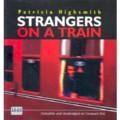
Strangers on a Train, by Patricia Highsmith, Read by William Roberts, ISIS Publishing Ltd., 2000
Fans of the Alfred Hitchcock adaptation of Patricia Highsmith’s debut novel, Strangers on a Train, will discover that it resembles the film mostly in the initial set up of the plot, then diverges rapidly away from the more standard, cinematic thriller fare. As the movie harkens back to Hitchcock’s earlier days, the film stock mirrored Hitch’s more black and white worldview, the villains nastier, the heroes purer. Highsmith’s novel would have fit better in his later canon when morality was a far more mixed up affair. To see the originally shot version and to compare with the bowdlerized, released film is to see a movie much closer in spirit if not execution to the novel.
A Highsmith novel tends to feature villains who are mostly, if not almost entirely sympathetic, heroes deeply flawed, psychological interplay between doubles, riffs on the theme of identity, and an underlying homoeroticism surprising for that time period. To read Strangers on a Train years after The Talented Mr. Ripley is to see the same sensibility informing both works . While remaking a Hitchcock film is seen as near blasphemy, Highsmith’s work would be well rewarded by the treatment of our more open age.
The plot of the book is of a piece with other murder books of the fifties, with the Leopold & Loeb murders hanging over everything (despite the three decades that had passed since), revisited in the public’s eye with the Clutter murders and the sensationalist nature of the Ed Gein case later that decade. Freudianism truly came into popular culture then as well, providing pseudo-rationalizations for many crimes, and the entire decade is littered with fictionalized intellectual killings, more about proving you can kill someone as a mental exercise or as a dare or because of deep-seated sexual maladjustment rather than as an exercise of rage.
The novel tells the story of Guy Haines, estranged from his first wife and seeking a second in the person of his mistress, Ann. On a cross country train ride to meet Ann, he makes the acquaintance of a young, rich drunkard Charles Bruno. Bruno presents Guy with the idea that they should each commit murder for the other, Bruno will kill Guy’s wife, Miriam, and in return Guy will kill Bruno’s father who’s grown tired of supporting a wastrel son. The idea is that having had no previous connection, the two men will kill strangers and leave no apparent motive for the crimes.
While Bruno moves quickly on his end, Guy spends a great deal of time trying to convince himself that the man was only kidding. After Miriam’s death, this becomes harder, especially as it is clearly murder, but Guy, who is essentially a decent individual, is a portrait of how people lie to themselves in order to avoid facing unpleasant conclusions. Highsmith expertly portrays the psychological strain this takes on Guy’s mental health especially once Bruno begins to demand Guy keep up his end of the “deal,” threatening to accuse him of conspiring in the murder unless he kills Bruno’s father.
What Highsmith doesn’t come out and say about the two men’s psychology is a clever dance around the mores of the 1950s in which allusions leer toward Bruno’s latent homosexual longings for Guy, while Guy himself, vulnerable in his agitated state, responds to this attraction with alternating revulsion and attraction. There is a great deal of the Oedipal motif, though this is applied in a clunky, pop culture fashion with a too overt and too overwrought mother-son relationship that is outright creepy and misses the subtlety of Freud’s conceptions utterly.
Better portrayed is the curious reversal in Bruno’s mind, recreating Guy and Miriam as his parents but with reversed attractions, suggesting to some degree the loathing behind Bruno’s doting on his mother. Once he’s killed Miriam, he is nearly wild with a sexual passion for a woman, despite having been grossly offended and disgusted by Miriam’s obvious sensuality. This is a fine and gently made contradiction, something only faintly echoed throughout the rest of the book, but it gives the character study something more than the simple one-dimensional Freudian portrait I’d begun to dread.
Guy’s eventual collapse is also an obvious psychological signpost and acutely seethes with tension, a first time novelist’s clear talent shining through. As in many of the best of noir fiction from this time period, the actual murder itself plays a small role in stage time, the bulk of the story focused on the disintegration of personalities in the aftermath of crime. This is best epitomized in the novels of James M. Cain whose sensibility and themes overshadowed many a younger novelist. That influence is most obvious in Strangers on a Train when the family investigator Gerard begins digging up contradictions and turning the screws on Bruno. Here the novel becomes an excruciating cat and mouse game of tensed nerves and leading questions.
Reader William Roberts is adequate to the task, transparent in a manner that never gets in the way of the novel, but with light crisp tones that make listening enjoyable, even as the novel ratchets up its capacity to register discomfort. His vocals have the ability to grow tighter and more clipped in the scenes of high stress, bringing a nice mirroring effect to a book already drenched in tension.
No comments:
Post a Comment